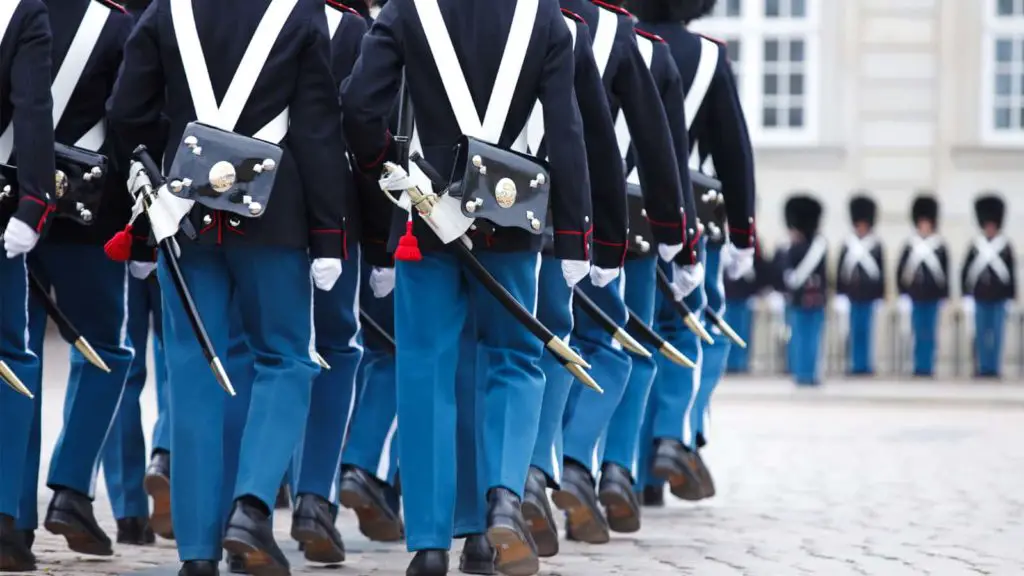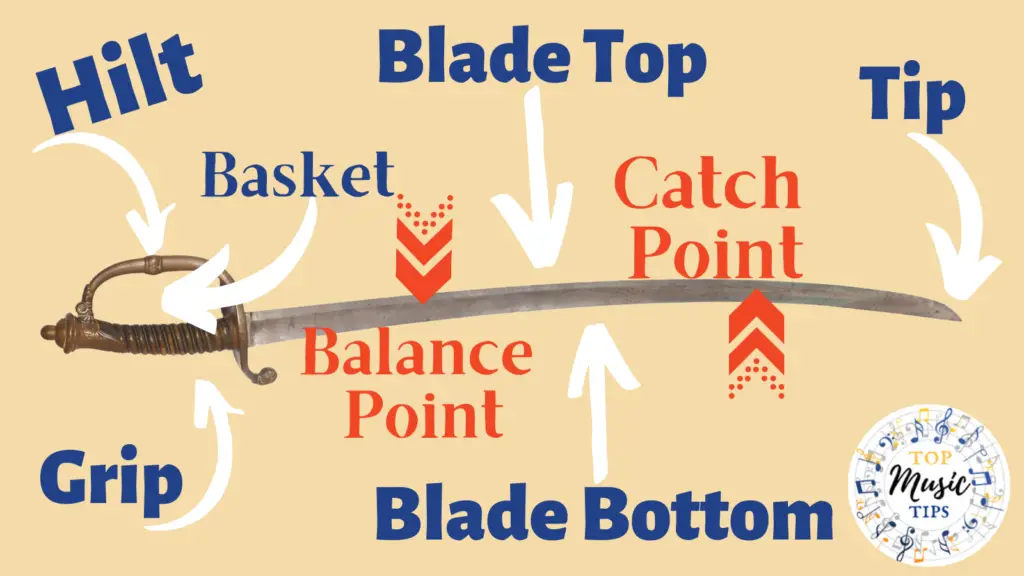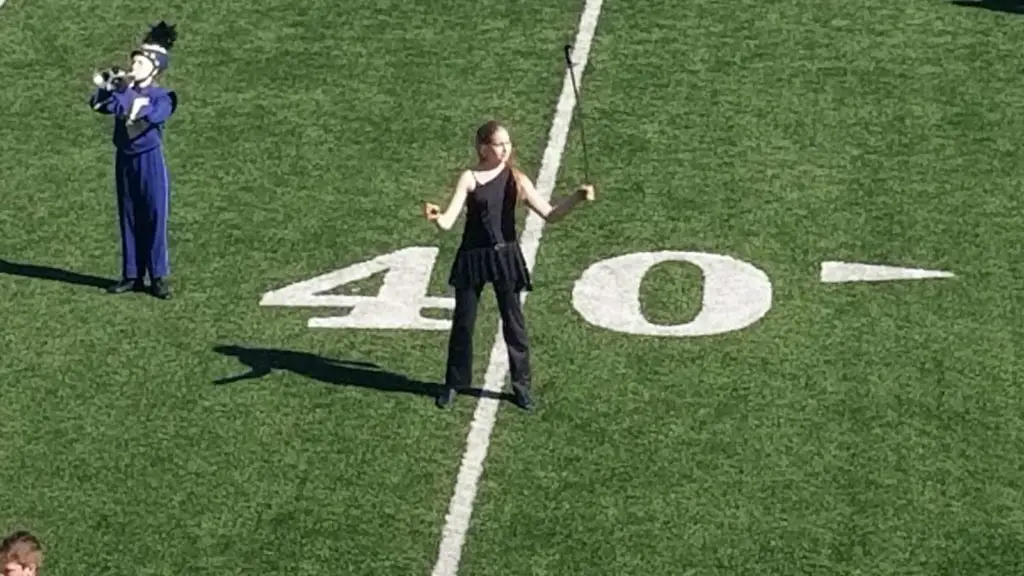When I first heard that my daughter would be twirling a sabre around as part of her role in Winter Guard I was somewhat shocked and concerned, as any parent might be learning their child would be throwing around a sharp object.
So I took to good old Google to see what I needed to know and was somewhat disappointed in the results. None of the information seemed to be just what I was looking for, so I’ve done a massive amount of research and am here to share with you what I’ve learned.
What is a Color Guard Sabre?
A sabre is a long heavy cavalry sword with a curved blade and a single cutting edge. Used in Color Guard or Winter Guard the cutting edge is dull and usually taped making it easier to spin throw and catch as a part of the show.
Color Guard Sabre History
Spinning flags always made sense to me, but when I heard about Color Guard members spinning Sabres (swords), and riffles I was surprised and a bit confused. So why do they use riffles and sabres in color and winter guard? I had to dig into the history to find the answers.
The use of the sabres and rifles comes from tradition. In past wars (civil and others) Color Guard was an important part of battlefield combat. Sabres and rifles were used to protect the flag (colors) from attack. Now in modern Color Guard, they are used as symbols of protecting the colors.

I love watching period shows with my husband that shows the valiant soldiers heading into battle to protect their country and freedoms. It really gets me excited when I see a little marching band accompanying them. The soldiers are often carrying their long swords (sabres) and rifles into battle with them.
The Soldiers in the band were often accompanied by soldiers carrying their flags high above them as they marched. This symbolized their battle towards freedom and also offered a beacon of hope for the soldiers who were going to sacrifice so much.
Often in battle, the fields would become so confusing and smoky it was difficult to see what position they needed to be in. The colors of the flag would help them find their way back to commanding officers.
Thankfully today the sabre and rifle are not functional. Color Guard sabres and rifles have been specially made and retrofitted to look like the real thing, but not cause harm or danger.
Different Parts of a Sabre

How much does a Color Guard Sabre Cost?
The average price for a new 39′ Color Guard Sabre is around $70-$120, but they can range in price from $50 for a used sabre all the way to $220 for a high-end sabre.
When I looked at prices for sabres it seemed like there was a wide range, but I didn’t find any that cost over $220. You will pay a different price depending on a few different factors including but not limited to.
- The length – 32′ sabres are $10-15 less than 36′, and 36′ sabres are generally about $10-20 less expensive than 39′
- The Brand – Here is a list of the different Sabre Brands that I found. From least expensive to most expensive.
- DSI Samurai $50-$65
- StylePlus Valerian $123-$132
- DSI Excalibur $128-$140
- King $205-$220
The Excalibur Sabre is the official sabre of choice for the WGI (Winter Guard International) and is recommended to use for competitions
As far as quality goes. The most serious color guard members who are doing a lot of competitive shows will use the King Sabre. The King sabre is a made-to-order sabre that is perfectly weighted and made completely of stainless steel. This sabre is likely to last the longest, look the nicest, and be the most durable of the choices.
If you are doing Color or Winter Guard with your high school or college band or drumline any of the options should work just fine for you to get started.
How much does a Color Guard Sabre weigh?
A Color Guard Sabre weighs approx 1.6 lbs (25.6 oz). Depending on the length of the blade it can range from 1.3 lbs (21 oz) – 1.8 lbs (29 oz).
Taping the blade may add an oz or two, but generally, you can expect your sabre to be fairly lightweight.

How and Why to Tape a Color Guard Sabre?
Knowing how to properly tape your sabre is an important part of being in Color/Winter Guard. Tape is used to protect your sabre from damage as well as your hands. You should tape your sabre to match what the rest of your Color Guard team is doing.
Here are some reasons why you need to tape your sabre
- Taping adds friction and grip that make it easier to catch your sabre.
- It provides your sabre with protection against nicks and scratches if you were to drop it.
- It provides a little extra cushion and comfort for your hands as you catch it.
- It helps bridge the gab between the weight of your sabre and your rifle so it’s not as difficult to switch between the two.
There are a few different types of tape you can use. You can get this less expensive tape which is good for the first layer if you are taping two layers or this tape which is the best tape to use on your sabre it holds up well and stays clean and shinny a lot better than other cheaper tape.
There are 4 different ways to tape your sabre.
- Minimalistic – Only tape the concave side of the sabre, or the top side (when the hilt is pointed down). Also, tape your catch point and balance point.
- Length Wise – Using 4 long pieces of tape, tape each flat side first and then tape the around the edges.
- Half Spiral – Starting at the balance point tape in a spiral fashion from there to the tip leaving the bottom (from the hilt to the catch point) silver and untaped.
- Full Spiral – Tape from the hilt to the tip sprilaring around the blade making sure that the overlap is the same on each rotation. You can also add another layer spiraling the opposite direction making x’s with the first spiral as you move down.
The way you tape your sabre is going to depend a lot on what your coach or instructor wants. All members of the Color/Winter Guard should have a uniformed look to their sabre.
You should always mark your catch point and Balance point after you tape the rest of the blade that way if it’s not even or needs to be moved you don’t have to un-tape your entire sabre.
How to Toss a Color Guard Sabre
Tossing and learning how to spin your sabre for the first time can be daunting and frightening for some. Most likely you have learned a lot of basics already while spinning your flag. A lot of it will be similar, but you will need to get used to the different weight and feel that a sabre has from a flag or rifle.
Start slow and with the basics. Here are some videos that can help you get started.
Color Guard Sabre Basics / How-to / Routine
Every Color Guard / Winter Guard will have their own technique when teaching a basic routine, but if you are wanting to get some extra practice in, here is a great video that will take you through a basic routine for your sabre.
Other FAQ’s about Color Guard Sabres
What is the sword called in Color Guard?
A sword in Color Guard is called a sabre. It is longer and thinner than a standard sword with a dull blade and a blunt tip.
Is it spelled Sabre or Saber?
Both spellings sabre and saber can be used interchangeably. In color guard, the spelling sabre is most often used and preferred.
Color Guard Practice Sabre
There isn’t really a difference between a regular color Guard Sabre and a practice sabre. A practice sabre would just be a sabre that is less expensive and is only used for practice so that you don’t damage your show sabre. A good practice sabre is any used or inexpensive sabre.
Where can I get a Color Guard Sabre Cheap?
You can save money on buying a Color Guard sabre for by buying one used. Ask your local color/winter guard captain if they know of any previous students that may want to sell theirs.
You can look on e-bay, KSL, as well as local Facebook marketplace groups. If you are near a location of a WGI competition you can check to see if any of the groups are selling used sabres.
If you are looking for the most inexpensive Color Guard Sabre you can check the price on this one from Amazon (affiliate link).
Color Guard Sabre Gloves
Gloves are a must when you are learning and performing with a sabre in color guard or winter guard. Gloves will protect your hands from blisters and pain and help you to have a better grip while catching your sabre tosses.
Our top pick for the Best Sabre Color Guard Gloves.
Disclaimer: This post may contain affiliate links. We only recommend high-quality products that are used and recommended by real musicians. If you use these links to buy something we earn a small commission.

